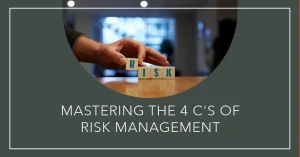Introduction to IAM III Certification
In the evolving landscape of internal audit and risk management, certifications play a pivotal role in establishing professional standards and enhancing the credibility of practitioners. One such certification is the IAM III (Internal Audit Management III) certification, which is designed to equip internal auditors and risk managers with advanced skills and knowledge necessary for effective governance and risk management. This section delves into the IAM III certification, its objectives, and its significance in the realm of internal audit.
Linking IAM III Certification to Risk Management Strategies
The IAM III certification stands out as a pivotal credential for professionals aiming to enhance their expertise and effectiveness. This certification not only equips individuals with essential skills but also aligns closely with the strategic objectives of risk management. In this section, we will explore the key skills and knowledge areas gained through IAM III certification, how these can be applied to risk assessment and mitigation, and present case studies that illustrate the successful integration of IAM III principles into risk strategies.
Key Skills and Knowledge Areas Gained Through IAM III Certification
The IAM III certification, which stands for Internal Audit Management Level III, is designed for experienced internal auditors who are looking to deepen their understanding of advanced auditing practices and risk management. Key skills and knowledge areas acquired through this certification include:
- Advanced Risk Assessment Techniques: IAM III certification provides auditors with sophisticated methodologies for identifying, analyzing, and prioritizing risks within an organization. This includes understanding both qualitative and quantitative risk assessment tools, which are crucial for effective risk management[1].
- Strategic Planning and Governance: The certification emphasizes the importance of aligning internal audit functions with organizational goals and governance frameworks. This strategic perspective is vital for risk managers who need to ensure that risk management practices support overall business objectives[2].
- Regulatory Compliance and Ethical Standards: IAM III covers the regulatory landscape and ethical considerations that impact risk management. Understanding these elements helps auditors ensure that their organizations comply with relevant laws and regulations, thereby mitigating legal and reputational risks[3].
- Communication and Stakeholder Engagement: Effective communication skills are a cornerstone of the IAM III curriculum. Auditors learn to engage with stakeholders at all levels, facilitating discussions about risk and fostering a culture of transparency and accountability within the organization[4].
Application of IAM III Skills to Risk Assessment and Mitigation
The skills acquired through IAM III certification can be directly applied to enhance risk assessment and mitigation strategies in several ways:
- Holistic Risk Identification: By utilizing advanced risk assessment techniques, certified professionals can identify risks that may not be immediately apparent. This holistic approach allows organizations to address potential vulnerabilities before they escalate into significant issues[5].
- Integration of Risk Management into Business Processes: IAM III-trained auditors can effectively integrate risk management practices into existing business processes. This ensures that risk considerations are embedded in decision-making, leading to more informed and strategic choices[6].
- Development of Risk Mitigation Plans: With a strong foundation in strategic planning, IAM III professionals are well-equipped to develop comprehensive risk mitigation plans. These plans can include specific actions, timelines, and responsibilities, ensuring that risks are managed proactively rather than reactively[7].
Case Studies: Successful Integration of IAM III Principles into Risk Strategies
To illustrate the practical application of IAM III principles in risk management, consider the following case studies:
- Case Study 1: Financial Services Firm
A leading financial services firm implemented IAM III principles to enhance its risk management framework. By adopting advanced risk assessment techniques, the firm identified previously overlooked operational risks. The internal audit team collaborated with management to develop targeted mitigation strategies, resulting in a 30% reduction in operational incidents over two years[8]. - Case Study 2: Healthcare Organization
A healthcare organization utilized IAM III certification to align its internal audit function with its strategic goals. The certified auditors conducted a comprehensive risk assessment that identified compliance risks related to patient data management. By integrating risk management into their governance framework, the organization improved compliance rates and reduced the likelihood of data breaches, thereby protecting its reputation and patient trust[9].
Challenges in Risk Management for Internal Auditors
Internal auditors face a myriad of challenges that can significantly impact their effectiveness. As organizations navigate complex regulatory environments and adapt to emerging risks, the role of internal auditors becomes increasingly critical. This section explores the prevalent challenges faced by internal auditors in risk management and how IAM III certification can empower them to address these issues effectively.
Prevalent Challenges in Risk Management
- Regulatory Changes
One of the most significant challenges internal auditors encounter is the constant flux of regulatory requirements. Organizations must comply with a variety of laws and standards, which can change frequently. This dynamic environment necessitates that auditors stay informed about new regulations and understand their implications for risk management practices. Failure to comply can lead to severe penalties and reputational damage, making it imperative for auditors to be proactive in their approach to compliance[1]. - Evolving Risks
The nature of risks is continually changing, influenced by factors such as technological advancements, market dynamics, and global events. Internal auditors must be adept at identifying and assessing these evolving risks, which can range from cybersecurity threats to operational disruptions. The challenge lies in not only recognizing these risks but also in developing effective strategies to mitigate them. This requires a deep understanding of the organization’s operations and the external environment[2]. - Integration of Risk Management Frameworks
Many organizations struggle with integrating risk management frameworks into their overall business strategy. Internal auditors often find themselves in a position where they must evaluate the effectiveness of these frameworks while ensuring alignment with organizational goals. This integration is crucial for fostering a risk-aware culture and ensuring that risk management is not viewed as a separate function but as an integral part of the business[3]. - Resource Constraints
Internal audit departments frequently operate under resource constraints, including limited budgets and personnel. This can hinder their ability to conduct thorough risk assessments and audits. Auditors must prioritize their efforts and focus on high-risk areas, which can be challenging when resources are stretched thin. Effective risk management requires a balance between thoroughness and efficiency, a task that can be daunting under such constraints[4].
How IAM III Certification Equips Auditors
The IAM III certification is designed to enhance the skills and knowledge of internal auditors, particularly in the realm of risk management. Here’s how this certification can help auditors navigate the aforementioned challenges:
- Enhanced Knowledge of Regulatory Frameworks
IAM III certification provides auditors with a comprehensive understanding of various regulatory frameworks and compliance requirements. This knowledge equips them to stay ahead of regulatory changes and implement necessary adjustments in their audit processes, thereby reducing the risk of non-compliance[5]. - Risk Assessment Techniques
The certification program emphasizes advanced risk assessment techniques, enabling auditors to identify and evaluate emerging risks effectively. By mastering these techniques, auditors can develop more robust risk management strategies that are responsive to the changing risk landscape[6]. - Integration Skills
IAM III certification fosters skills that facilitate the integration of risk management frameworks into business strategies. Auditors learn how to align risk management with organizational objectives, ensuring that risk considerations are embedded in decision-making processes[7]. - Continuous Learning and Adaptation
The IAM III certification underscores the importance of continuous learning and adaptation in risk management. Auditors are encouraged to stay updated on industry trends, emerging risks, and best practices, which is essential for maintaining an effective risk management posture in a rapidly changing environment[8].
Developing a Strategic Risk Management Framework
In today’s complex business environment, the integration of risk management strategies with robust internal audit practices is essential for organizational resilience. The IAM III certification, which focuses on advanced internal auditing techniques and risk management principles, provides a valuable foundation for risk managers and internal auditors. This section outlines the steps to develop a strategic risk management framework, emphasizes the role of internal auditors, and discusses how IAM III principles can be integrated into risk management practices.
Steps to Develop a Strategic Risk Management Framework
- Establish the Context
The first step in developing a strategic risk management framework is to establish the context in which risks will be assessed. This involves understanding the organization’s objectives, the external environment, and the internal capabilities. A clear context helps in identifying relevant risks and aligning risk management efforts with organizational goals. - Risk Identification
Once the context is established, the next step is to identify potential risks that could impact the organization. This can be achieved through various methods, including brainstorming sessions, interviews with stakeholders, and analysis of historical data. The IAM III certification emphasizes the importance of a comprehensive risk identification process, ensuring that both internal and external risks are considered[1]. - Risk Assessment
After identifying risks, organizations must assess their potential impact and likelihood. This involves qualitative and quantitative analysis to prioritize risks based on their significance. Internal auditors play a crucial role in this phase by providing insights into risk assessment methodologies and ensuring that assessments are objective and thorough[2]. - Risk Response Planning
Developing strategies to mitigate identified risks is essential. This may include risk avoidance, reduction, sharing, or acceptance. The IAM III principles advocate for a proactive approach to risk response, encouraging organizations to implement controls and measures that align with their risk appetite and strategic objectives[3]. - Monitoring and Review
A strategic risk management framework is not static; it requires continuous monitoring and review. Organizations should establish key performance indicators (KPIs) to track the effectiveness of risk management strategies. Internal auditors are instrumental in this process, as they can provide independent assessments of the risk management framework’s performance and suggest improvements[4]. - Communication and Reporting
Effective communication of risk management strategies and outcomes is vital for stakeholder engagement. Internal auditors should ensure that risk reports are clear, concise, and tailored to the audience, facilitating informed decision-making at all levels of the organization[5].
The Role of Internal Auditors in Shaping the Framework
Internal auditors are pivotal in shaping and enhancing the strategic risk management framework. Their expertise in evaluating risk management processes allows them to identify gaps and recommend improvements. By conducting regular audits, they can ensure that risk management practices are aligned with IAM III principles, fostering a culture of accountability and transparency within the organization. Furthermore, internal auditors can facilitate training and awareness programs to enhance the organization’s overall risk management capabilities[6].
Integrating IAM III Certification Principles into Risk Management Practices
The IAM III certification provides a comprehensive understanding of advanced internal auditing and risk management techniques. By integrating these principles into risk management practices, organizations can enhance their ability to identify, assess, and respond to risks effectively. Key IAM III principles that can be applied include:
- Risk-Based Auditing: Focusing audit efforts on areas with the highest risk exposure ensures that resources are allocated efficiently and effectively[7].
- Continuous Improvement: Emphasizing the need for ongoing evaluation and enhancement of risk management practices aligns with the dynamic nature of risks faced by organizations today[8].
- Stakeholder Engagement: Involving stakeholders in the risk management process fosters a collaborative approach, ensuring that diverse perspectives are considered in decision-making[9].
Future Trends in Internal Audit and Risk Management
As the landscape of internal audit and risk management continues to evolve, certifications like IAM III (Internal Audit Management III) play a pivotal role in shaping the skills and strategies of professionals in the field. This section explores the anticipated future developments influenced by such certifications, focusing on technological advancements, the evolving skill set required for auditors, and the ongoing relevance of IAM III certification in professional development.
Technological Advancements and Their Impact on Risk Management
The rapid pace of technological innovation is transforming the way organizations approach risk management. Emerging technologies such as artificial intelligence (AI), machine learning, and data analytics are becoming integral to internal audit processes. These tools enable auditors to analyze vast amounts of data quickly, identify anomalies, and assess risks more effectively than traditional methods allow[1].
For instance, AI can automate routine audit tasks, freeing up auditors to focus on more strategic activities, such as risk assessment and mitigation strategies. Additionally, data analytics can provide deeper insights into organizational risks, allowing for proactive rather than reactive risk management[2]. As these technologies become more prevalent, the IAM III certification will likely emphasize the importance of technological proficiency, ensuring that auditors are equipped to leverage these tools effectively in their risk management strategies.
Evolving Skill Set for Auditors in a Changing Landscape
The role of internal auditors is expanding beyond traditional compliance and financial oversight to encompass a broader understanding of organizational risk. As risk landscapes become more complex, auditors must develop a diverse skill set that includes not only technical auditing skills but also competencies in data analysis, cybersecurity, and strategic thinking[3].
The IAM III certification is designed to address these evolving needs by providing auditors with advanced knowledge and skills necessary for effective risk management. Future iterations of the certification may incorporate modules on emerging technologies, risk assessment frameworks, and strategic risk management practices, ensuring that certified professionals remain relevant in a rapidly changing environment[4]. This evolution in skill requirements underscores the importance of continuous professional development and the need for auditors to stay abreast of industry trends.
Future Relevance of IAM III Certification in Professional Development
As organizations increasingly recognize the value of effective risk management, certifications like IAM III will continue to gain prominence. The IAM III certification not only validates an auditor’s expertise but also signals to employers a commitment to professional growth and adherence to best practices in risk management[5].
Looking ahead, the relevance of IAM III certification is likely to be amplified by the growing demand for auditors who can navigate complex risk environments. Organizations will seek professionals who possess a blend of technical skills and strategic insight, making IAM III certification a valuable asset for career advancement in internal audit and risk management[6]. Furthermore, as regulatory requirements evolve and organizations face new challenges, the certification will serve as a benchmark for auditors aiming to enhance their credibility and effectiveness in risk management roles.
Conclusion
In conclusion, the IAM III certification stands as a pivotal credential for internal auditors and risk managers, underscoring its significance in the realm of risk management. This certification not only equips professionals with advanced knowledge and skills but also enhances their ability to identify, assess, and mitigate risks effectively within their organizations. By understanding the intricate relationship between identity and access management (IAM) and risk strategies, certified individuals can contribute to a more robust risk management framework, ensuring that organizations are better prepared to face the complexities of today’s cybersecurity landscape.
Moreover, the pursuit of ongoing professional development through certifications like IAM III is essential for staying abreast of evolving risks and best practices. As the field of risk management continues to grow and change, internal auditors and risk managers must commit to lifelong learning to maintain their expertise and effectiveness. This commitment not only benefits their careers but also strengthens the overall risk posture of their organizations.
We encourage our readers to consider the IAM III certification as a strategic investment in their professional development. By obtaining this certification, you will not only enhance your own capabilities but also play a crucial role in fostering a culture of risk awareness and proactive management within your organization. Embrace the opportunity to elevate your career and contribute to the success of your organization by pursuing IAM III certification today.
Find out more about Shaun Stoltz https://www.shaunstoltz.com/about/
This post was written by an AI and reviewed/edited by a human.



